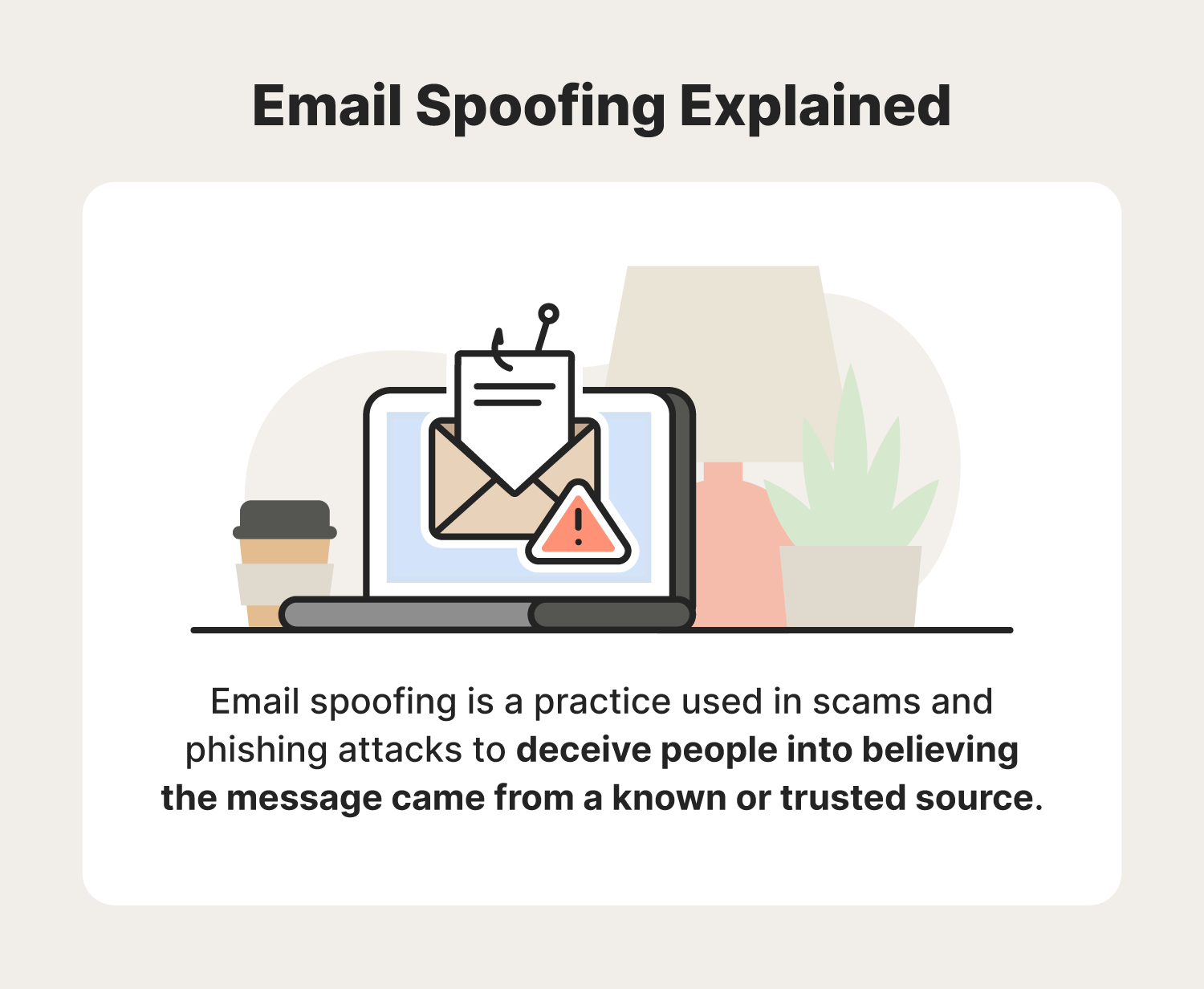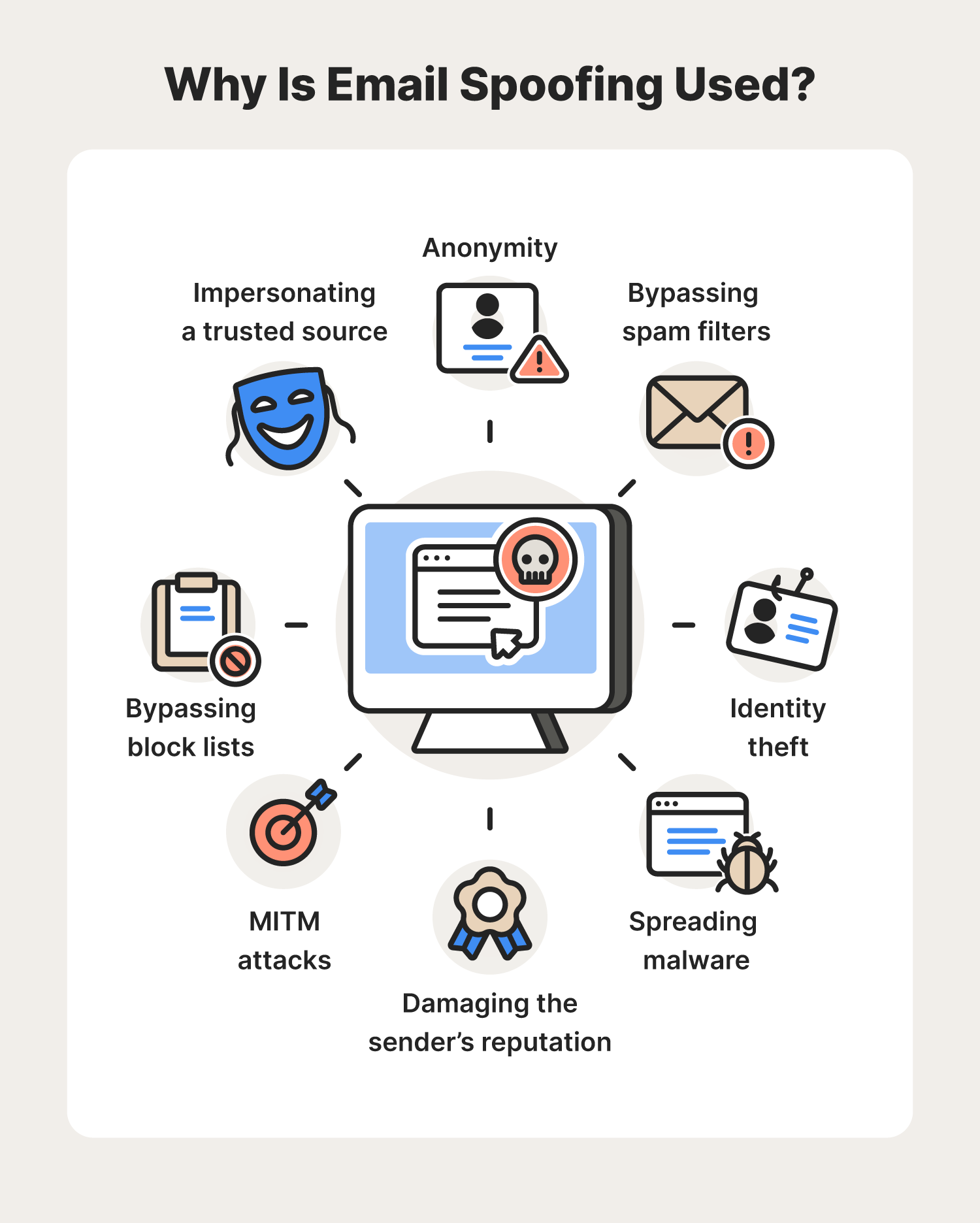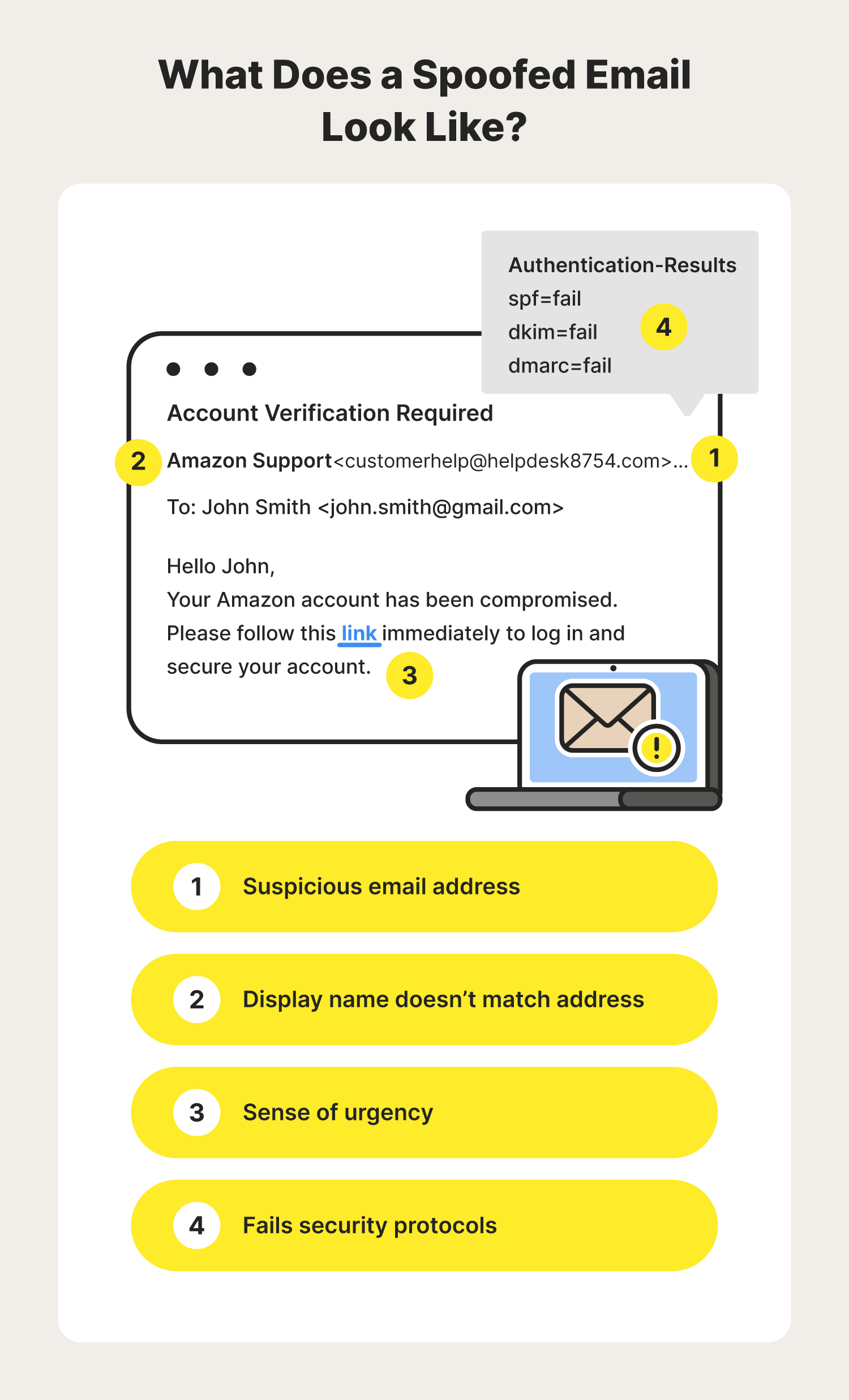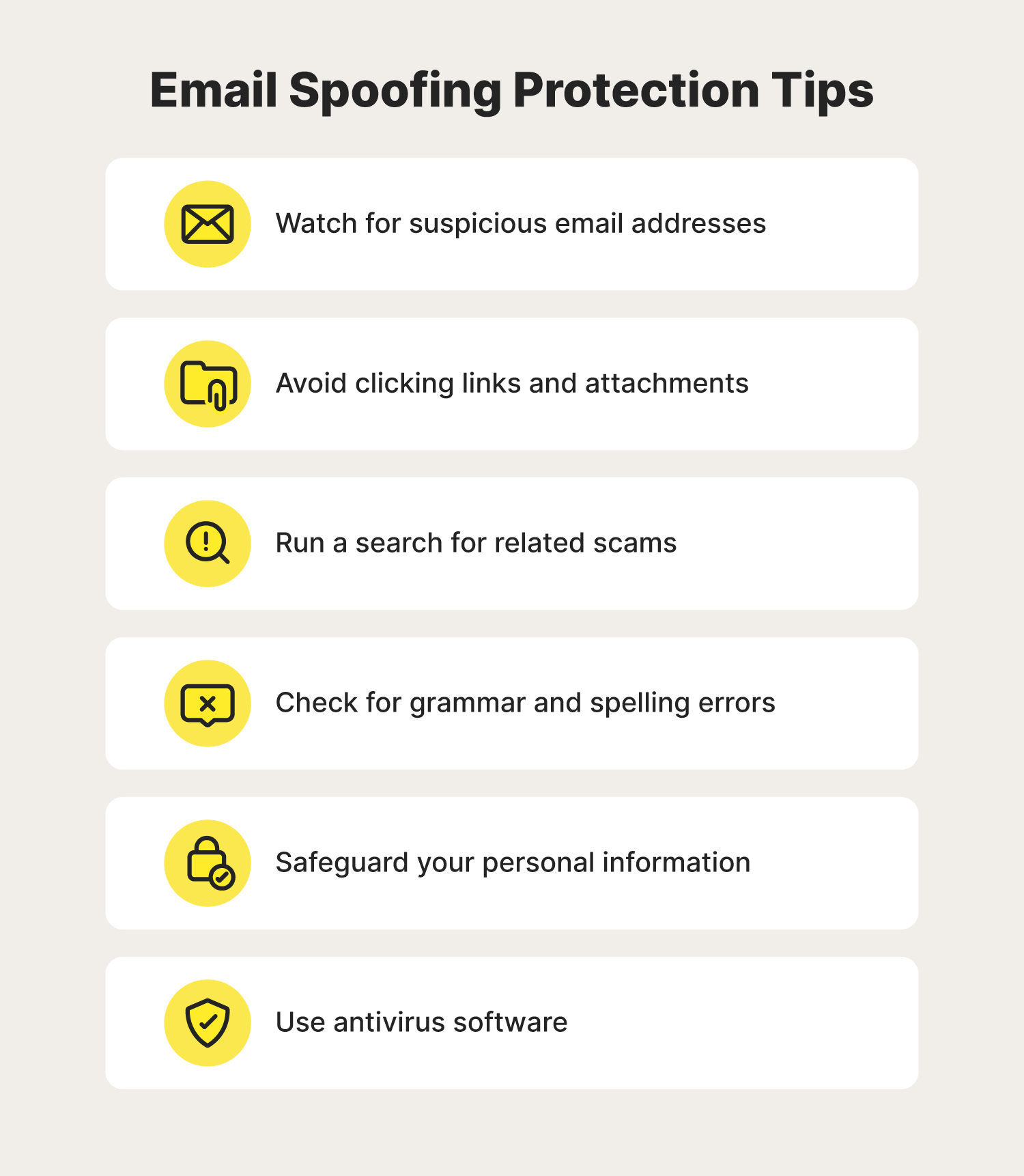What is email spoofing? A complete guide

Have you ever read an email and wondered if it truly came from the listed sender? If so, it may be email spoofing. To learn more about email spoofing, follow this guide.
Email spoofing definition
Email spoofing is a practice used in scams and phishing attacks to deceive people into believing the message came from a known or trusted source.
Have you ever opened an email from someone you know only to be unsure if it was them who wrote the message?
Whether it seems like a spam email or they asked you a personal question they already know the answer to, it's possible the sender may not be who they appear to be.
How, you ask? The answer is email spoofing.

Email spoofing is a practice used in scams and phishing attacks to deceive people into believing the message came from a known or trusted source. Cybercriminals use this technique hoping that the recipient will not notice and engage with the message as if it’s a legitimate email.
But before you start second-guessing every email you’ve ever received, read through this complete guide where we’ll cover how email spoofing works, what it looks like, and how you can protect yourself from it.
How does email spoofing work? + 3 types of email spoofs
In simple terms, the goal of email spoofing is to make the recipient believe the email is coming from someone they can trust. Then the attacker exploits that trust, whether they use it for phishing, spreading different types of malware, or tarnishing the sender's reputation. To help you understand how email spoofing works, here are three different ways an email spoofer may try to trick you.
Display name spoofing
Display name spoofing is an example of spoofing email headers where only the sender’s display name is falsified. With this type of email spoofing, the email address itself will not match the display name attached to the email. For example, you may get an email that says it is coming from your boss, but after opening the message, you notice that the sender’s email address does not match your boss’s.
This is possible if a cybercriminal creates a new email address under your boss’s name. Because the email itself is legitimate, this type of spoofed email might bypass any spam filters, therefore easily making it into your inbox.
Legitimate domain spoofing
Legitimate domain spoofing is a much more believable email spoofing example. In this case, both the display name and the sender’s address will be fake. Cybercriminals can do this by taking advantage of Simple Mail Transfer Protocol (SMTP), which is an email protocol used for sending messages.
During normal email communications, your email client (Gmail, Outlook, etc.) will automatically enter the sender’s address whenever an email is sent. In the event of email spoofing, the attacker can manipulate this information, making it seem as if the email is coming from someone else. Because SMTP does not provide a way to authenticate email addresses, the scammer can manually change the “To,” “From,” and “Reply To” fields when sending spoofing emails.
Look-alike domain spoofing
Another example of email spoofing is the use of look-alike domains. An example of a spoofed domain is “amaz0n.com.” In this specific scenario, the spoofer created a domain attempting to impersonate “amazon.com.” At first glance, you may not notice that the “o” has been replaced with a “0.”
This technique can be effective if you don’t pay close attention to the spoofed email header, especially if the contents of the email look legitimate. Because of this, it’s important to always pay close attention to the sender’s details before engaging with an email.
Plus: What’s the difference between email spoofing vs. phishing?
At first glance, email spoofing may sound a lot like phishing, and in some cases, the two do involve each other. But these two cybersecurity threats are different. Phishing is another type of cyberattack utilized by cybercriminals to try and lure sensitive information from you. This can take place over text, email, social media, or on the phone (an attack also known as vishing).
No matter where this attack takes place, the main goal of phishing is to access your personal information for fraudulent activities such as identity theft. Email address spoofing may play a crucial role in these attacks, allowing the cybercriminal to appear as if they are somebody else.
But phishing isn't the only reason a cybercriminal may use email spoofing to their advantage. Let’s look at some other reasons for email spoofing.

Reasons for email spoofing
While email spoofing is often used for phishing attacks, there are many other reasons a cybercriminal might try spoofing an email address, including:
- Anonymity: Email spoofing can help conceal the sender's identity, allowing them to carry out attacks without fear of the recipient knowing who they truly are.
- Bypassing spam filters: Most email providers have built-in spam filters that can help filter out a lot of spam emails. By utilizing email spoofing, an attacker may be able to sneak into your inbox.
- Impersonating a trusted individual or organization: Similar to catfishing, email spoofing may be used to impersonate someone you know or a trusted organization in hopes that you’ll disclose personal information they wouldn’t be able to access otherwise.
- Identity theft: Some spoofed email messages are designed to trick you into giving up login credentials or other personal identifying information, which could lead to identity theft.
- Bypassing block lists: Like bypassing spam filters, email spoofing may be used to send a spoofed email to a recipient who they would otherwise be blocked from communicating with.
- Spreading malware: A spoof email may contain malicious links with malware, which could damage your device and put your cybersecurity at risk.
- Man-in-the-middle (MITM) attacks: In some cases, email spoofing is used to carry out MITM attacks, which also involve phishing. A common example of this is when an attacker impersonates your bank using a fake sender email address and website link.
- Damaging the sender’s reputation: Because a spoofed message looks like it’s coming from someone else, a cybercriminal could use the message to tarnish the sender’s reputation by sending lies or rude messages.
As you can see, there are many reasons why a cybercriminal might use email spoofing to their advantage. But how does email spoofing work?
How to spot a spoofed email

Now that you know the different ways an email spoofer could try to impersonate another sender, you may be wondering how you can quickly spot a spoofed email.
Whenever you come across an email you’re unsure about, keep an eye out for these warning signs.
- Suspicious email address: Be sure to check and make sure that the email domain matches the correct domain of whomever the sender is claiming to be. Also, keep a close eye out for typos or look-alike domains.
- Display name doesn’t match address: Another hint of a spoofed email message is if the display name differs from the sender’s email address. If it's someone you’ve spoken with before, check and see if the current sender’s address matches the one used in previous communications.
- Sense of urgency: Because spoofed emails are often used for phishing or other types of cyberattacks, the sender may use social engineering tactics to create a sense of urgency, rushing you to respond or follow their instructions.
While it's possible that not every spoofing email will show these signs, carefully analyzing the sender’s address and display name can help you catch some spoofed emails that may have made it to your inbox. Fortunately, most popular email providers have put additional security frameworks in place to help detect spoofed emails, including:
- Sender Policy Framework (SPF): SPF checks to see if the sender’s IP address is associated with the email domain they are using when sending an email.
- DomainKeys Identified Mail (DKIM): DKIM works to verify that the email hasn’t been altered between the sender’s and recipient’s servers.
- Domain-based Message Authentication, Reporting, and Conformance (DMARC): DMARC gives the sender the option to inform the recipient that the email is protected by SPF or DKIM.
Not only do these security measures help alert users of spam and spoofed emails, but they can be used to help verify if an email is legitimate. To learn how you can use these security protocols to check the legitimacy of a message, follow the following steps based on your email provider.
How to check SPF, DKIM, and DMARC status on Gmail:
- View the email in question.
- Click the three-dot icon in the top right corner of the email.
- Select “Show original.”
- Check and see if the email is marked “pass” or “fail” for each section.
How to check SPF, DKIM, and DMARC status on Outlook:
- View the email in question.
- Click the three-dot icon in the top right corner of the email.
- Hover over “View” and then select “View message details.”
- Scroll through the details and view “Authentication-Results” to see if the email is marked “pass” or “fail” for each section.
How to check SPF, DKIM, and DMARC status on Yahoo Mail:
- View the email in question.
- Click the three-dot icon in the top right corner of the email.
- Select “View raw message.”
- Scroll through the details and view “Authentication-Results” to see if the email is marked “pass” or “fail” for each section.
By taking these additional precautions, you can be sure that you’re dealing with a legitimate sender, therefore reducing the risk of a spoofed email address going unnoticed.
How to protect against email spoofing: 6 protection tips

In addition to doing your best to identify a spoofed email before responding, there are precautions you can take to protect yourself from email spoofing. To help keep yourself Cyber Safe while using email, follow these protection tips:
- Watch for suspicious or unknown email addresses: One of the first indicators of many spoofed emails is the use of a suspicious email address. In some cases, the email address could contain typos or replace letters with numbers.
- Avoid clicking links and attachments: Be sure to avoid clicking any links or attachments, as spoofed emails may contain links that can take you to malicious websites or expose you to malware.
- Run a search for related scams: If an email seems suspicious, copy and paste the contents of the email into a search engine. It’s possible that the email has been sent to others before, and it may have been reported as a scam somewhere online.
- Check for grammar and spelling errors: In many cases, spoofed emails contain spelling and grammatical errors that a legitimate message would not.
- Safeguard your personal information: Always think twice before sharing any sort of personal information online. If you do, be sure to verify that you’re sharing it with a reliable person or organization.
- Use antivirus software: Antivirus software can help protect your device from the dangers of email spoofing like phishing, malware, and identity theft.
Now that you have a better understanding of email spoofing and how you can protect yourself against it, you can follow up, circle back, and send with confidence. Above all, it’s important to always use common sense and be cautious, as there are other threats that can impact your email security.
FAQs about email spoofing
Still have more questions? We’ve got answers. Read along to learn answers to these commonly asked questions about email spoofing.
What’s the difference between a spoofed and hacked account?
The difference between a spoofed and hacked email account is that a hacked account means that the hacker has gained full access to your email account, allowing them to send legitimate messages from your address. In the event that your email address is spoofed, the hacker will only be attempting to make it look as if the message is coming from you, but they won't have access to your account.
Can email spoofing be traced?
Generally speaking, yes, email spoofing can be traced. This is due to a security protocol known as Sender Policy Framework (SPF), which can locate the sender’s IP address.
Can someone use my email address without me knowing it?
Unfortunately, there is no way to completely prevent cybercriminals from attempting to use your email address. However, there are precautions you can take to prevent a scammer from logging into your email account, such as using strong passwords and enabling two-factor authentication.


Try Norton 360 FREE 7-Day Trial* - Includes Norton Secure VPN
7 days of FREE* comprehensive antivirus, device security and online privacy with Norton Secure VPN.
Join today. Cancel anytime.
*Terms Apply
Editorial note: Our articles provide educational information for you. Our offerings may not cover or protect against every type of crime, fraud, or threat we write about. Our goal is to increase awareness about Cyber Safety. Please review complete Terms during enrollment or setup. Remember that no one can prevent all identity theft or cybercrime, and that LifeLock does not monitor all transactions at all businesses. The Norton and LifeLock brands are part of Gen Digital Inc.





Want more?
Follow us for all the latest news, tips and updates.